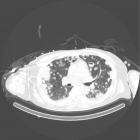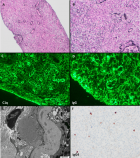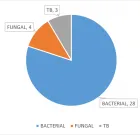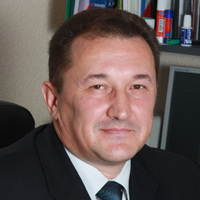Abstract
Editorial
CRISPR genome editing: A general view
Ram Mohan Ram Kumar*
Published: 23 June, 2017 | Volume 1 - Issue 1 | Pages: 001-002
CRISPR technology has presented a path forward for genomic engineering and gene modification. The framework for the use of CRISPR technology to manipulate the human genome is of great interest and the form of its development and application has excited the researchers and biotech communities as the number of publications citing CRISPR gene targeting system has rose predominantly as indexed in PubMed. From a technical standpoint of view, most of us think that this would be relatively straightforward process, but technical feasibility is never the only consideration in doing experiments. Much of the discussion about CRISPR engineering has revolved mostly around its ability for treating disease or editing the genes of human embryos. In the real sense, what the biologists desire about CRISPR is its specificity: the ability to target and determine particular DNA sequences in the genome circuit.
Read Full Article HTML DOI: 10.29328/journal.jgmgt.1001001 Cite this Article Read Full Article PDF
References
- Barrangou R. RNA events. Cas9 targeting and the CRISPR revolution. Science. 2014; 344: 707-708. Ref.: https://goo.gl/PDBhc1
- Xie F, Ye L, Chang JC, Beyer AI, Wang J, et al. Seamless gene correction of β-thalassemia mutations in patient-specific iPSCs using CRISPR/Cas9 and piggyBac. Genome Res. 2014; 24: 1526-1533. Ref.: https://goo.gl/4JWJM4
- Ebina H, Misawa N, Kanemura Y, Koyanagi Y. Harnessing the CRISPR/Cas9 system to disrupt latent HIV-1 provirus. Sci Rep. 2013; 3: 2510. Ref.: https://goo.gl/BFzgBn
- Schwank G, Koo BK, Sasselli V, Dekkers JF, Heo I, et al. Functional repair of CFTR by CRISPR/Cas9 in intestinal stem cell organoids of cystic fibrosis patients. Cell Stem Cell. 2013; 13: 653-658. Ref.: https://goo.gl/82stVs
- Li HL, Fujimoto N, Sasakawa N, Shirai S, Ohkame T, et al. Precise correction of the dystrophin gene in duchenne muscular dystrophy patient induced pluripotent stem cells by TALEN and CRISPR-Cas9. Stem Cell Reports. 2015; 4:143-54. Ref.: https://goo.gl/zHQsA6
- Long C, Amoasii L, Mireault AA, McAnally JR, Li H, et al. Postnatal genome editing partially restores dystrophin expression in a mouse model of muscular dystrophy. Science. 2016; 351: 400-403. Ref.: https://goo.gl/e9FdEx
- Nelson CE, Hakim CH, Ousterout DG, Thakore PI, Moreb EA, et al. In vivo genome editing improves muscle function in a mouse model of Duchenne muscular dystrophy. Science. 2015; 351: 403-407. Ref.: https://goo.gl/2boVPL
- Tabebordbar M, Zhu K, Cheng JK, Chew WL, Widrick JJ, et al. In vivo gene editing in dystrophic mouse muscle and muscle stem cells. Science. 2015; 351: 407-411. Ref.: https://goo.gl/pm4wZ5
- Iyombe-Engembe JP, Ouellet DL, Barbeau X, Rousseau J, Chapdelaine P, et al. Efficient Restoration of the Dystrophin Gene Reading Frame and Protein Structure in DMD Myoblasts Using the CinDel Method. Mol Ther Nucleic Acids. 2016; Ref.: https://goo.gl/mvNd4b
Figures:
Similar Articles
-
CRISPR genome editing: A general viewRam Mohan Ram Kumar*. CRISPR genome editing: A general view. . 2017 doi: 10.29328/journal.jgmgt.1001001; 1: 001-002
-
Progress in the development of Lipoplex and Polyplex modified with Anionic Polymer for efficient Gene DeliveryYoshiyuki Hattori*. Progress in the development of Lipoplex and Polyplex modified with Anionic Polymer for efficient Gene Delivery. . 2017 doi: 10.29328/journal.jgmgt.1001002; 1: 003-018
-
The advances and challenges of Gene Therapy for Duchenne Muscular DystrophyJacques P Tremblay*,Jean-Paul Iyombe-Engembe. The advances and challenges of Gene Therapy for Duchenne Muscular Dystrophy. . 2017 doi: 10.29328/journal.jgmgt.1001003; 1: 019-036
-
The role of genetic mutations in genes LMNA, PPARG, PLIN1, AKT2, CIDEC in Köbberling–Dunnigan SyndromeShahin Asadi*,Mahsa Jamali. The role of genetic mutations in genes LMNA, PPARG, PLIN1, AKT2, CIDEC in Köbberling–Dunnigan Syndrome. . 2019 doi: 10.29328/journal.jgmgt.1001004; 2: 001-006
-
Reasons why new coronavirus, SARS-CoV-2 infections are likely to spreadTakuma Hayashi*,Takashi Ura,Kaoru Abiko,Masaki Mandan,Nobuo Yaegashi,Ikuo Konishi. Reasons why new coronavirus, SARS-CoV-2 infections are likely to spread. . 2020 doi: 10.29328/journal.jgmgt.1001005; 3: 001-003
-
Partial SHOX duplications associated with various cases of congenital uterovaginal aplasia (MRKH syndrome): A tangible evidence but a puzzling mechanismDaniel Guerrier*,Karine Morcel. Partial SHOX duplications associated with various cases of congenital uterovaginal aplasia (MRKH syndrome): A tangible evidence but a puzzling mechanism. . 2021 doi: 10.29328/journal.jgmgt.1001006; 4: 001-008
-
New insights of liquid biopsy in ovarian cancerPanagiotis Antoniadis*,Florentina Alina Gheorghe,Madalina Ana Maria Nitu,Cezara Gabriela Nitu,Diana Roxana Constantinescu,Florentina Duica. New insights of liquid biopsy in ovarian cancer. . 2022 doi: 10.29328/journal.jgmgt.1001007; 5: 001-011
-
Individual Treatment Trial of PIGV-Associated Mabry Syndrome with D-Mannose in a Young ChildMarta Agnes Somorai*, Annabelle Arlt, Peter Krawitz, Jochen Baumkötter, Volker Mall. Individual Treatment Trial of PIGV-Associated Mabry Syndrome with D-Mannose in a Young Child. . 2023 doi: 10.29328/journal.jgmgt.1001008; 6: 001-004
-
Management and Therapeutic Strategies for Spinal Muscular AtrophySheena P Kochumon, Cherupally Krishnan Krishnan Nair*. Management and Therapeutic Strategies for Spinal Muscular Atrophy. . 2024 doi: 10.29328/journal.jgmgt.1001009; 7: 001-007
-
A Critical Review on Some Recent Developments in Comparison of Biological SequencesDK Bhattacharya*. A Critical Review on Some Recent Developments in Comparison of Biological Sequences. . 2024 doi: 10.29328/journal.jgmgt.1001010; 7: 008-014
Recently Viewed
-
Unusual Complications of a Dental Prosthesis Esophageal Foreign Body: About a CaseRichard Edward Alain Deguenonvo,Ndèye Fatou Thiam*,Mouhamadou Diouldé Diallo,Abdou Sy,Amadou Thiam,Abdoulaye Diop,Mame Sanou Diouf,Baye Karim Diallo. Unusual Complications of a Dental Prosthesis Esophageal Foreign Body: About a Case. Adv Treat ENT Disord. 2025: doi: 10.29328/journal.ated.1001016; 9: 001-004
-
Examining the Effects of High Poverty and Unemployment on Rural Urban Migration in Nigeria and its Consequences on Urban Resources and Rural DeclineTochukwu S Ezeudu*, Bilyaminu Tukur. Examining the Effects of High Poverty and Unemployment on Rural Urban Migration in Nigeria and its Consequences on Urban Resources and Rural Decline. J Child Adult Vaccines Immunol. 2024: doi: 10.29328/journal.jcavi.1001012; 8: 001-013
-
Betty Neuman System Model: A Concept AnalysisAdnan Yaqoob*, Rafat Jan, Salma Rattani and Santosh Kumar. Betty Neuman System Model: A Concept Analysis. Insights Depress Anxiety. 2023: doi: 10.29328/journal.ida.1001036; 7: 011-015
-
Host biomarkers for early diagnosis of infectious diseases: A comprehensive reviewArindam Chakraborty*,Singh Monica. Host biomarkers for early diagnosis of infectious diseases: A comprehensive review. Int J Clin Microbiol Biochem Technol. 2019: doi: 10.29328/journal.ijcmbt.1001005; 2: 001-007
-
Diabetes and red blood cell parametersMd. Sadikuj Jaman*,Md. Sohanur Rahman,Rubaiya Rafique Swarna,Joyanto Mahato,Md. Milon Miah,Mosa. Ayshasiddeka. Diabetes and red blood cell parameters. Ann Clin Endocrinol Metabol. 2018: doi: 10.29328/journal.acem.1001004; 2: 001-009
Most Viewed
-
Impact of Latex Sensitization on Asthma and Rhinitis Progression: A Study at Abidjan-Cocody University Hospital - Côte d’Ivoire (Progression of Asthma and Rhinitis related to Latex Sensitization)Dasse Sery Romuald*, KL Siransy, N Koffi, RO Yeboah, EK Nguessan, HA Adou, VP Goran-Kouacou, AU Assi, JY Seri, S Moussa, D Oura, CL Memel, H Koya, E Atoukoula. Impact of Latex Sensitization on Asthma and Rhinitis Progression: A Study at Abidjan-Cocody University Hospital - Côte d’Ivoire (Progression of Asthma and Rhinitis related to Latex Sensitization). Arch Asthma Allergy Immunol. 2024 doi: 10.29328/journal.aaai.1001035; 8: 007-012
-
Causal Link between Human Blood Metabolites and Asthma: An Investigation Using Mendelian RandomizationYong-Qing Zhu, Xiao-Yan Meng, Jing-Hua Yang*. Causal Link between Human Blood Metabolites and Asthma: An Investigation Using Mendelian Randomization. Arch Asthma Allergy Immunol. 2023 doi: 10.29328/journal.aaai.1001032; 7: 012-022
-
An algorithm to safely manage oral food challenge in an office-based setting for children with multiple food allergiesNathalie Cottel,Aïcha Dieme,Véronique Orcel,Yannick Chantran,Mélisande Bourgoin-Heck,Jocelyne Just. An algorithm to safely manage oral food challenge in an office-based setting for children with multiple food allergies. Arch Asthma Allergy Immunol. 2021 doi: 10.29328/journal.aaai.1001027; 5: 030-037
-
Snow white: an allergic girl?Oreste Vittore Brenna*. Snow white: an allergic girl?. Arch Asthma Allergy Immunol. 2022 doi: 10.29328/journal.aaai.1001029; 6: 001-002
-
Cytokine intoxication as a model of cell apoptosis and predict of schizophrenia - like affective disordersElena Viktorovna Drozdova*. Cytokine intoxication as a model of cell apoptosis and predict of schizophrenia - like affective disorders. Arch Asthma Allergy Immunol. 2021 doi: 10.29328/journal.aaai.1001028; 5: 038-040

If you are already a member of our network and need to keep track of any developments regarding a question you have already submitted, click "take me to my Query."
















































































































































